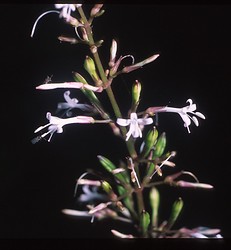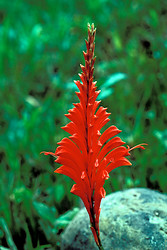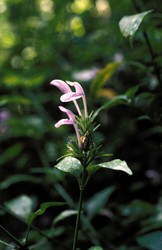Core Isoglossinae
Carrie Kiel


This tree diagram shows the relationships between several groups of organisms.
The root of the current tree connects the organisms featured in this tree to their containing group and the rest of the Tree of Life. The basal branching point in the tree represents the ancestor of the other groups in the tree. This ancestor diversified over time into several descendent subgroups, which are represented as internal nodes and terminal taxa to the right.

You can click on the root to travel down the Tree of Life all the way to the root of all Life, and you can click on the names of descendent subgroups to travel up the Tree of Life all the way to individual species.
For more information on ToL tree formatting, please see Interpreting the Tree or Classification. To learn more about phylogenetic trees, please visit our Phylogenetic Biology pages.
close boxIntroduction
Isoglossinae are a subtribe of the wide ranging and taxonomically difficult tribe Justicieae (Acanthaceae). There are an estimated 200 species in about 13 genera. Isgolossinae are distributed in tropical and subtropical parts of the Americas, Africa and Southeast Asia. The lineage is the subject of a published paper by Kiel et al. (2006). The core group of Isoglossinae includes New World genera Razisea, Kalbreyeriella, Habracanthus, Stenostephanus, and Hansteinia and Old World genera Brachystephanus and Oreacanthus (both African), Isoglossa (Africa and Asia), and Conocalyx and Sphacanthus (both Malagasy). In both the New and Old World, generic delimitations have been controversial. A number of authors have suggested that all New World members of core Isoglossinae be treated as Stenostephanus. Champluvier (in preparation) has suggested that African Oreacanthus be synonymized with Brachystephanus. Presumably associated with pollinator relationships, the plants have diverse floral morphological characters including several groups with remarkably showy hummingbird flowers in the New World.
Characteristics
Core Isoglossinae have a distinct pollen type known as “Gürtelpollen.” As the name suggests, the pollen is distinguished by a girdled band around its circumference. This characteristic is hypothesized to be a morphological synapomorphy for the group. Another characteristic of core Isoglossinae is the presence of two stamens with mono- or dithecous anthers. Both Isoglossa and Conocalyx have dithecous anthers whereas Brachystephanus and all New World genera have monothecous anthers.

Gürtelpollen of Razisea wilburii. © Lucinda A. McDade
Ptyssiglottis was treated by Hansen (1992) as part of Isoglossinae. Interestingly, Ptyssiglottis has dithecous anthers like Isoglossa and Conocalyx but lacks the "Gürtelpollen" synapomorphy common to all core Isoglossinae. Our results are inconclusive with regard to the placement of Ptyssiglottis and we are addressing relationships of this genus as part of a larger scale study of Justicieae.
Discussion of Phylogenetic Relationships
The phylogenetic study of Kiel et al. (2006) indicated that Core Isoglossinae (i.e., Isoglossa, Conocalyx, Brachystephanus, and all New World Isoglossinae) are monophyletic with very strong support. Conocalyx and Isoglossa form a strongly supported clade. Conocalyx, a monotypic genus from Madagascar, is clearly not phylogenetically distinct from species placed in Isoglossa and, given the morphological diversity of Isoglossa, Conocalyx does not seem especially morphologically distinctive. Our results concur with Champluvier's suggestion that Oreacanthus does not merit recognition in that the sampled members of this genus did not form a clade distinct from Brachystephanus. Instead all sampled species of Oreacanthus and Brachystephanus were placed as a paraphyletic series of lineages basal to and within the clade that comprises all sampled New World species. Relationships among New World Isoglossinae remain unresolved except that the small, mostly Central American genus Razisea is monophyletic.
The monophyly of Isoglossinae including Ptyssiglottis is weakly supported in our study and the lineage is not present in all of the most parsimonious trees. Our data strongly support monophyly of Ptyssiglottis but we are not yet able to place the genus with confidence within Isoglossinae. Further assessment of the relationships of this genus requires more data or more comprehensive taxon sampling.
References
Benoist, R. 1967. Contribution á la connaissance des Acanthacées malgaches. Bull. Soc. Bot. France 113: 531–536.
Bremekamp, C. E. B. 1965. Delimitation and subdivision of the Acanthaceae. Bull. Bot. Surv. India 7: 21–30.
Champluvier, D. 1994. Brachystephanus myrmecophilus (Acanthaceae), Espèce nouvelle du Zaïre oriental: un cas intéressant de myrmécophile. Belg. J. Bot. 127: 45–60.
Champluvier, D. Ms submitted. Revision of the genera Brachystephanus and Oreacanthus (Acanthaceae) in Tropical Africa. (reviewed and under revision for Bot. J. Linn. Soc.)
Daniel, T. F. 1999. Revision of Stenostephanus (Acanthaceae) in Mexico. Contr. Univ. Michigan Herb. 22: 47–93.
Hansen, B. 1985. Taxonomic revision of the SE Asian species of Isoglossa (Acanthaceae). Nord. J. Bot. 5: 1–13.
Hansen, B. 1992. The genus Ptyssiglottis (Acanthaceae). A taxonomic monograph. Opera Bot. 116: 1–58.
Kiel, C. A., L. A. McDade, T. F. Daniel, and D. Champluvier. 2006. Phylogenetic delimitation of Isoglossinae (Acanthaceae: Justicieae) and relationships among constituent genera. Taxon 55 (3): 683-694.
Leonard, E. C. 1958. The Acanthaceae of Colombia, III. Contr. U. S. Natl. Herb. 31:119–322.
Lindau, G. 1895. Acanthaceae. Pp. 274–354 in: Engler, A. & Prantl, K. (eds.), Die natürlichen Pflanzenfamilien 4(3b). Engelmann, Leipzig.
McDade, L. A., Daniel, T. F., Masta, S. E. & Riley, K. M. 2000a. Phylogenetic relationships within the tribe Justicieae (Acanthaceae): Evidence from molecular sequences, morphology, and cytology. Ann. Missouri Bot. Gard. 87: 435–458.
McDade, L. A., Masta, S. E. Moody, M. L. & Waters, E. 2000b. Phylogenetic relationships among Acanthaceae: evidence from two genomes. Syst. Bot. 25: 105–120.
Muller, J., Schuller, M., Straka, H., & Friedrich, B. 1989. Palynologia Madagassica et Mascarenica. Familien 60, 98. 98ter, 111, 120, 182, 182bis, 183, 189, Addenda. Trop. Subtrop. Pflanzenwelt 67: 1–225.
Scotland, R. W. & Vollesen, K. 2000. Classification of Acanthaceae. Kew Bull. 55: 513–589.
Wasshausen, D. C. & Wood, J. R. I. 2001. Further discoveries in the genus Stenostephanus (Acanthaceae). Harvard Pap. Bot. 6: 449–454.
Wasshausen, D. C. & Wood, J. R. I. 2004. Acanthaceae of Bolivia. Contr. U. S. Natl. Herb. 49: 1–152.
Wood, J. R. I. 1988. Colombian Acanthaceae—Some new discoveries and some reconsiderations. Kew Bull. 43: 1–51.
About This Page
Carrie Kiel

Rancho Santa Ana Botanic Garden
Correspondence regarding this page should be directed to Carrie Kiel at
Page copyright © 2007 Carrie Kiel
All Rights Reserved.
- First online 26 June 2007
- Content changed 26 June 2007
Citing this page:
Kiel, Carrie. 2007. Core Isoglossinae. Version 26 June 2007 (under construction). http://tolweb.org/Core_Isoglossinae/52332/2007.06.26 in The Tree of Life Web Project, http://tolweb.org/











 Go to quick links
Go to quick search
Go to navigation for this section of the ToL site
Go to detailed links for the ToL site
Go to quick links
Go to quick search
Go to navigation for this section of the ToL site
Go to detailed links for the ToL site